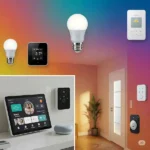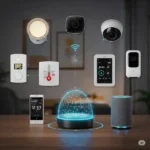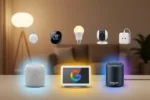Wellness in the Connected Home: Smart Devices for Health Monitoring and Better Sleep
The concept of “home” is evolving. It’s no longer just a place to eat and sleep; it’s becoming a hub for personal well-being, thanks to the rise of smart health devices. From tracking vital signs to optimizing your sleep environment, connected technologies are empowering us to take a more proactive role in our health from the comfort of our living spaces. This article will explore key smart devices, popular brands, and how they integrate with your digital life to foster a healthier home. Learn how to have a smart home wellness connected home.
The Rise of Health-Centric Smart Home Wellness
The Internet of Things (IoT) has brought unprecedented connectivity to our homes. Beyond smart lighting and voice assistants, a growing category of devices is specifically designed to monitor our health and improve our well-being. This shift reflects a growing awareness of the impact our environment has on our physical and mental state.
Why embrace a smart home wellness-focused home?
- Proactive Health Management: Gain insights into your body’s metrics and make informed lifestyle choices.
- Improved Sleep Quality: Create an optimal sleep environment to enhance restorative rest.
- Enhanced Indoor Air Quality: Breathe cleaner air, reducing the risk of respiratory issues.
- Convenience and Automation: Seamlessly integrate health routines into your daily life.
- Early Detection: Some devices can flag potential health concerns, prompting earlier consultation with medical professionals.
Key Smart Devices for a Healthier Home
Let’s dive into some of the most impactful smart devices contributing to smart home wellness in the connected home:
1. Smart Scales: Beyond Just Weight
Forget the old-fashioned bathroom scale. Smart scales offer a comprehensive look at your body composition, providing data far beyond just your weight.
How they work: Using Bioelectrical Impedance Analysis (BIA), these scales send a small, safe electrical current through your body to estimate various metrics.
Key Metrics Tracked:
- Weight
- Body Mass Index (BMI)
- Body Fat Percentage
- Muscle Mass
- Bone Mass
- Water Percentage
- Visceral Fat
- Heart Rate (some models)
Popular Brands & Models:
- Withings Body Cardio: A premium option known for its accuracy, comprehensive metrics including Pulse Wave Velocity (arterial health), and seamless integration with the Withings Health Mate app.
- Etekcity HR Smart Fitness Scale: A highly-rated, affordable option tracking numerous metrics with Wi-Fi connectivity and integration with Apple Health, Google Fit, and Fitbit.
- QardioBase X: Offers highly accurate body fat percentage measurements and works on various surfaces, including carpets.
- Xiaomi Mi Body Composition Scale 2: A popular budget-friendly choice that tracks various body composition metrics and integrates with the Mi Fit app.
- Eufy Smart Scale P2 Pro: Feature-packed, offering 16 metrics including resting heart rate and body age.
2. Sleep Trackers: Unlocking Restful Nights
Sleep is fundamental to our health, and smart sleep trackers provide invaluable insights into your sleep patterns, helping you optimize your rest.
How they work: Sleep trackers use various sensors (accelerometers, heart rate monitors, temperature sensors) to detect sleep stages, duration, and disturbances. They come in different forms:
- Wearable Devices (Smartwatches/Rings): Worn on your wrist or finger.
- Under-Mattress Sensors: Discreetly placed beneath your mattress.
- Bedside Devices: Use radar or other technology to monitor sleep without direct contact.
Key Metrics Tracked:
- Sleep Stages (Light, Deep, REM)
- Sleep Duration
- Sleep Quality Score
- Awakenings
- Heart Rate Variability (HRV)
- Respiratory Rate
- Snoring Detection (some models)
- Bedtime and Wake-up Times
Popular Brands & Models:
- Oura Ring (Gen 4): A sleek and comfortable ring that provides in-depth sleep analysis, readiness scores, and tracks other health metrics like body temperature and stress. Highly acclaimed for its accuracy and comfort. (SmartRingSupport.com)
- WHOOP 4.0 Band: A screen-less strap focusing on recovery, strain, and sleep, offering personalized insights and coaching based on your biometric data.
- Apple Watch Series 10 (for iPhone users): Excellent for overall health tracking, including robust sleep tracking with detailed sleep stages and the potential for sleep apnea detection. Integrates seamlessly with Apple Health. (SmartWatchSupport.com)
- Samsung Galaxy Watch Ultra / Galaxy Ring (for Android users): Offer comprehensive sleep tracking, including snore detection (Galaxy Ring), and integrate with the Samsung Health app.
- Withings Sleep Analyzer (Under-Mattress): A non-wearable option that tracks sleep cycles, heart rate, breathing, and can detect sleep apnea.
- Google Nest Hub (2nd Gen) (Bedside): Uses Sleep Sensing technology to track sleep without a wearable, offering personalized insights and recommendations (requires a subscription for full features).
3. Smart Air Purifiers: Breathing Easier
Indoor air quality can significantly impact your health, contributing to allergies, asthma, and other respiratory issues. Smart air purifiers detect pollutants and automatically adjust their filtration to maintain healthy air.
How they work: Equipped with sensors, these purifiers monitor particulate matter (PM2.5, PM10), volatile organic compounds (VOCs), and other allergens. They use multi-stage filtration (HEPA, activated carbon) to remove contaminants.
Key Features:
- Real-time Air Quality Monitoring
- Automatic Adjustment based on Air Quality
- HEPA and Activated Carbon Filtration
- App Control and Scheduling
- Voice Assistant Integration (Alexa, Google Assistant, Siri, HomeKit)
- Filter Life Indicators
Popular Brands & Models:
- Dyson Purifier Cool TP07 / Big+Quiet Formaldehyde BP03: Premium options that combine air purification with a fan, offering detailed air quality data and excellent filtration.
- Coway Airmega 250S: A popular choice for larger rooms, known for its strong performance and smart features.
- Rabbit Air A3 Air Purifier: Offers extensive customization options and a sleek, wall-mountable design.
- Smartmi Air Purifier P1: A portable and effective option with smart home integration.
- Blueair Blue 511i Max Smart WiFi Air Purifier: Known for its compact design and powerful performance in tackling high-pollution areas.
- AiDot WELOV Matter P200 Pro Smart Air Purifier: A highly interoperable option with Matter support for broader smart home integration.
4. Other Health-Centric Devices
The smart home wellness landscape is constantly expanding. Here are a few other notable categories:
- Smart Thermometers: Like the Withings Thermo, these contactless thermometers provide accurate readings and sync data to your health app for tracking trends.
- Smart Blood Pressure Monitors: Devices like the Omron HeartGuide (a wearable blood pressure monitor) or traditional smart cuffs from Withings allow for easy, regular monitoring and data sharing with your doctor.
- Smart Light Bulbs & Systems (Circadian Lighting): Brands like Philips Hue offer bulbs that can adjust color temperature and brightness throughout the day to align with your body’s natural circadian rhythms, promoting better sleep and wakefulness.
- Smart Home Hubs with Health Features: Devices like the Google Nest Hub (2nd Gen) can integrate with various health devices and, as mentioned, offer contactless sleep tracking.
Wearable Devices: Your Personal Health Companions (iPhone & Android)
Wearable devices, primarily smartwatches and fitness trackers, are at the forefront of personal health monitoring. They offer continuous data collection and are compatible with both iPhone and Android ecosystems.
Popular Wearable Brands & Models:
- Apple Watch (for iPhone users): The gold standard for iPhone users, offering comprehensive health tracking including ECG, blood oxygen, temperature sensing, fall detection, and robust fitness tracking. Integrates deeply with Apple Health.
- Samsung Galaxy Watch (for Android users): A strong contender for Android users, featuring body composition analysis, ECG, blood pressure monitoring (in select regions/models), and integration with Samsung Health.
- Google Pixel Watch (for Android users): Powered by Fitbit, it offers excellent sleep tracking and overall fitness insights for Android users, integrating with Google Fit and Fitbit apps.
- Fitbit Devices (Versa, Charge, Inspire): Known for their user-friendly interface and focus on fitness and sleep tracking. Compatible with both iOS and Android. Their app is a central hub for all tracked data.
- Garmin Smartwatches: Popular among athletes and fitness enthusiasts, offering advanced metrics for training, recovery, and robust health tracking. Integrates with Garmin Connect.
Built-in and Third-Party Apps: The Brains Behind the Data
The hardware is only as good as the software that interprets and presents the data. Both built-in and third-party apps play crucial roles in your smart home wellness journey.
Built-in Apps (Platform-Specific):
- Apple Health (iOS): A centralized hub on iPhones that aggregates health data from various compatible apps and devices (including Apple Watch, Withings, Etekcity). It offers a dashboard view of your metrics and allows for secure sharing with healthcare providers.
- Google Fit (Android): Similar to Apple Health, Google Fit collects data from Android phones, Wear OS watches, and compatible third-party devices. It provides insights into activity, heart rate, sleep, and more.
- Samsung Health (Android): Samsung’s dedicated health platform for Galaxy devices and compatible wearables. It offers a wide range of tracking features and integrates with Samsung’s ecosystem.
- Fitbit App (iOS & Android): The core of the Fitbit ecosystem, providing detailed insights into activity, sleep, stress, and nutrition. It offers guided programs and community features.
- Garmin Connect (iOS & Android): Garmin’s comprehensive app for tracking all data from their devices, focusing heavily on fitness, training load, and recovery.
- Withings Health Mate (iOS & Android): A well-designed app that centralizes data from Withings smart scales, blood pressure monitors, sleep analyzers, and smartwatches. Known for its clear interface and health reports.
Third-Party Apps (Cross-Platform & Specialized):
Many smart health devices integrate with popular third-party apps, offering more specialized insights or allowing you to consolidate data from various brands.
- MyFitnessPal: Excellent for calorie and macro tracking, often integrating with smart scales and fitness trackers to sync weight and activity data.
- Sleep Cycle / Pillow: Dedicated sleep analysis apps that can work independently or integrate with wearables for more detailed sleep insights, including smart alarms.
- Headspace / Calm: Mindfulness and meditation apps that can help improve sleep quality and reduce stress, sometimes integrating with wearables to track stress levels.
- Lose It! / Noom: Weight loss and nutrition tracking apps that benefit from integration with smart scales.
- Strava / MapMyRun: Fitness tracking apps that can pull activity data from smartwatches for detailed workout analysis.
- IFTTT (If This Then That): A powerful automation tool that allows you to create custom connections between different smart devices and apps, for example, “If my sleep tracker detects I’m in deep sleep, then dim the smart lights.”
Comparison Chart: Smart Home Wellness Devices
| Device Type | Popular Brands/Models | Key Metrics/Features | Common App Integration | Price Range (Approx.) |
| Smart Scales | Withings Body Cardio, Etekcity HR, QardioBase X, Xiaomi | Weight, BMI, Body Fat, Muscle Mass, Bone Mass, Water %, Heart Rate (some) | Health Mate, VeSync, Qardio App, Mi Fit, Apple Health, Google Fit, Fitbit | $30 – $250 |
| Sleep Trackers | Oura Ring, WHOOP, Apple Watch, Samsung Galaxy Watch/Ring, Withings Sleep Analyzer, Google Nest Hub (2nd Gen) | Sleep Stages, Duration, Quality Score, Awakenings, HRV, Respiratory Rate, Snoring (some) | Oura App, WHOOP App, Apple Health, Samsung Health, Fitbit, Google Fit, Sleep Cycle | $100 – $400+ (plus subscriptions) |
| Air Purifiers | Dyson, Coway Airmega, Rabbit Air, Smartmi, Blueair, AiDot | Real-time Air Quality (PM2.5, VOCs), Auto-adjustment, HEPA/Carbon Filters, App/Voice Control | Dyson Link, Coway Airmega, Rabbit Air, Smartmi Link, Blueair, AiDot, Alexa, Google Home, HomeKit | $100 – $900+ |
| Wearables (General) | Apple Watch, Samsung Galaxy Watch, Google Pixel Watch, Fitbit, Garmin | Activity Tracking, Heart Rate, ECG, Blood Oxygen, Stress, Sleep, GPS, Notifications | Apple Health, Samsung Health, Google Fit, Fitbit, Garmin Connect, Strava | $100 – $800+ |
| Smart Blood Pressure | Withings BPM Connect, Omron HeartGuide | Systolic/Diastolic BP, Heart Rate | Health Mate, Omron Connect, Apple Health, Google Fit | $80 – $300 |
| Smart Lighting (Circadian) | Philips Hue, Lutron Caséta, LIFX | Color Temperature & Brightness adjustment, Scheduling, Scene creation | Philips Hue App, Lutron App, LIFX App, Apple HomeKit, Google Home, Alexa | $15 – $200+ (per bulb/kit) |
Note: Prices are approximate and can vary based on model, retailer, and promotions. Some devices may require subscriptions for full features.
Additional Helpful Content
- Setting Goals: Before investing, identify your health goals. Are you focused on weight loss, better sleep, managing a condition, or general wellness? This will help you choose the right devices.
- Interoperability: Consider how well devices from different brands communicate. While platforms like Apple Health and Google Fit act as central repositories, some devices offer tighter integration within their own ecosystems. Matter and Thread are emerging smart home standards aiming to improve interoperability.
- Privacy Settings: Understand and adjust the privacy settings on your devices and apps. You control who sees your data.
- Battery Life: For wearables, battery life is a significant factor. Consider how often you’re willing to charge.
- User Experience: Look for devices with intuitive apps and easy-to-understand data presentation. Overwhelming data can be counterproductive.
Troubleshooting Common Problems – Smart Home Wellness
Even the smartest devices can encounter hiccups. Here are some common problems and troubleshooting tips:
- Device Not Connecting to Wi-Fi/Bluetooth:
- Check Wi-Fi password: Ensure it’s entered correctly.
- Restart router: Unplug your Wi-Fi router for 30 seconds, then plug it back in.
- Restart device: Turn the smart device off and on again.
- Proximity: Move the device closer to your router.
- Network congestion: If many devices are on your network, try temporarily disconnecting some.
- Firmware update: Check if the device or app needs a software update.
- Inaccurate Readings from Smart Scale/Wearable:
- Placement: Ensure the smart scale is on a hard, flat surface (not carpet). For wearables, ensure a snug fit.
- Clean sensors: For scales, wipe down the surface. For wearables, ensure the heart rate sensors are clean and free of debris.
- Calibration: Some devices may offer a manual calibration option in their app.
- Consistency: Take measurements at the same time each day for better trend analysis (e.g., first thing in the morning).
- Hydration: Dehydration can affect BIA readings on smart scales.
- Consult manufacturer: If issues persist, contact the manufacturer’s support.
- App Not Syncing Data:
- Internet connection: Ensure both your phone and the device have a stable internet connection.
- App permissions: Check your phone’s settings to ensure the app has necessary permissions (e.g., Bluetooth, location).
- Background refresh: Ensure background app refresh is enabled for the health app.
- Log out/in: Try logging out of the app and logging back in.
- Re-pair device: Sometimes re-pairing the device with the app resolves syncing issues.
- Air Purifier Not Responding / Poor Performance:
- Filter life: Check if the filters need replacing. Clogged filters significantly reduce performance.
- Obstructions: Ensure the air intake and output are not blocked.
- Room size: Verify the purifier is rated for the size of your room.
- App/firmware update: Ensure the app and device firmware are up to date.
- Reset: Try a factory reset of the air purifier (consult manual).
Frequently Asked Questions (FAQ) – Smart Home Wellness
Q1: Are smart health devices accurate enough for medical purposes? A1: For many metrics, smart devices offer good accuracy for personal tracking and identifying trends. However, most consumer-grade devices are not medical devices and should not be used for diagnosis or treatment without professional medical advice. Always consult your doctor for any health concerns. Some devices (e.g., certain ECG or blood pressure monitors) may have FDA clearance, indicating a higher level of clinical validation.
Q2: What about data privacy and security with these devices? A2: Data privacy is a significant concern. Reputable brands employ encryption and secure servers to protect your health data. Always review the privacy policy of any device or app you use. Consider what data is collected, how it’s used, and if it’s shared with third parties. You often have control over data sharing permissions within the app.
Q3: Can these devices integrate with my existing smart home system (e.g., Apple HomeKit, Google Home, Alexa)? A3: Many smart health devices offer integration with popular smart home ecosystems, allowing for voice control, automation, and centralized management. Look for compatibility logos (e.g., “Works with Alexa,” “Works with Google Home,” “HomeKit Compatible”) when purchasing. Emerging standards like Matter aim to further improve cross-platform compatibility.
Q4: How often should I replace filters in my smart air purifier? A4: The replacement frequency depends on the model, usage, and indoor air quality. Most manufacturers recommend replacing HEPA filters every 6-12 months and activated carbon filters every 3-6 months. Your air purifier’s app or display will usually indicate filter life.
Q5: Do I need a subscription for these devices to work? A5: While many devices offer core functionality without a subscription, some brands offer premium features, deeper insights, personalized coaching, or historical data access through a subscription service. It’s important to check this before purchasing if budget is a concern.
Additional helpful information
Set up a smart home lighting center – Building Your Smart Home Lighting Control Center
External Links for Authoritative Sources:
- World Health Organization (WHO) – Air Quality: https://www.who.int/news-room/fact-sheets/detail/household-air-pollution-and-health
- Centers for Disease Control and Prevention (CDC) – Sleep and Sleep Disorders: https://www.cdc.gov/sleep/index.html
- American Heart Association (AHA) – Blood Pressure Monitoring: https://www.heart.org/en/health-topics/high-blood-pressure/monitoring-your-blood-pressure
- FDA (U.S. Food and Drug Administration) – Digital Health: https://www.fda.gov/medical-devices/digital-health-center-excellence
By strategically incorporating smart devices into your home, you can create an environment that actively supports your health and well-being, paving the way for a healthier, more informed, and more restful life.




